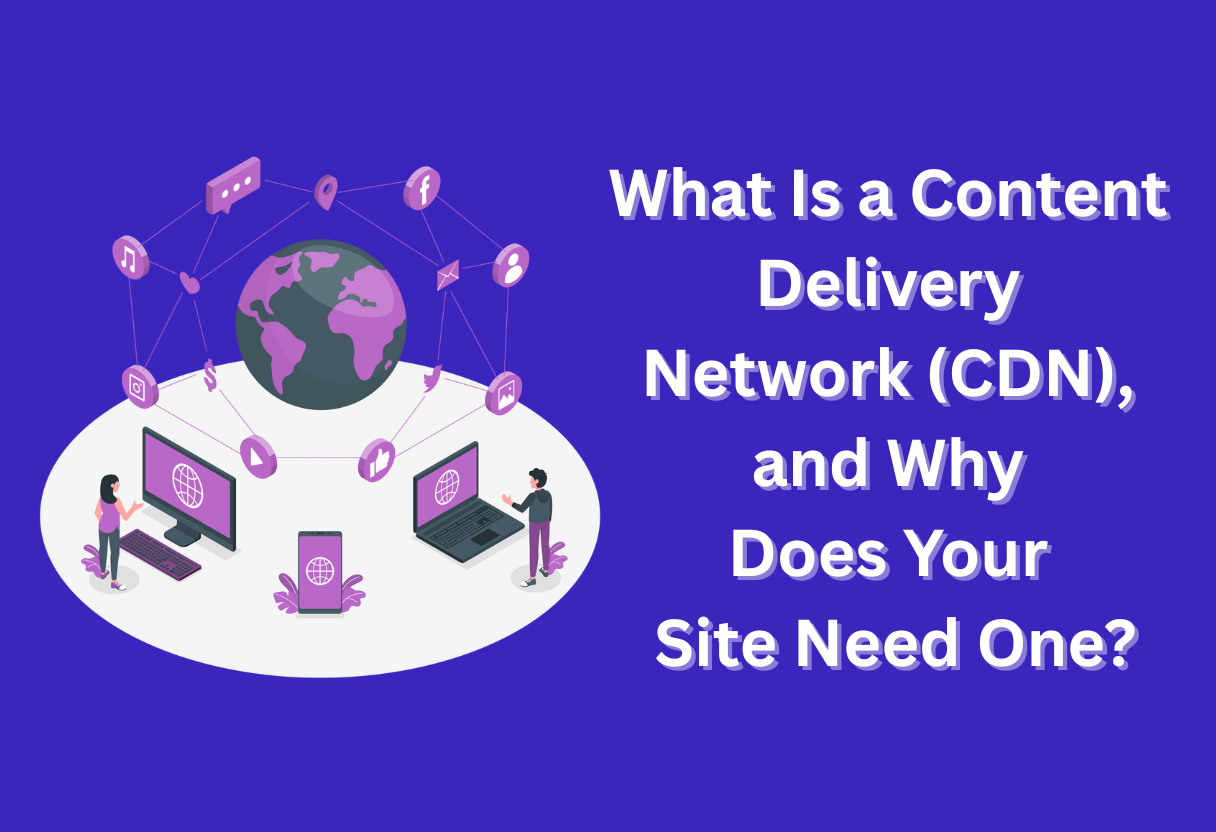There’s a good chance you’ve encountered the term Content Delivery Network (CDN) while managing your website, but you might be unsure of its significance. A CDN is imperatively a network of servers strategically located across various geographic areas that helps to deliver your website’s content to users more efficiently. By leveraging a CDN, you can enhance your site’s speed, improve user experience, and boost your site’s performance, especially for visitors who are located far away from your primary server. In this post, you will discover how a CDN can benefit your online presence.
Understanding Content Delivery Networks (CDNs)
Definition of a CDN
Your website’s performance largely depends on how quickly your content can be delivered to users. A Content Delivery Network (CDN) is a network of servers distributed globally that work together to provide fast delivery of your website content, such as images, videos, and scripts, by caching it closer to the users’ locations.
History and Evolution of CDNs
Across the years, the demand for faster web experiences has led to the development of CDNs. Initially, in the late 1990s, the need to offload traffic from origin servers sparked the creation of early CDN providers. These early solutions focused on static content delivery, which has since evolved to support dynamic content and a variety of media types.
Among the significant milestones in the evolution of CDNs was the shift from simple caching solutions to more complex architectures that include advanced technologies like load balancing, real-time analytics, and enhanced security features. This evolution reflects your growing need for a seamless online experience, addressing the challenges of latency and server overload as internet usage surged.
How CDNs Work
Below the surface, CDNs operate by distributing your content across multiple servers located in different geographical regions. When a user requests content from your website, the CDN fetches this content from the nearest server, significantly reducing loading times and improving user experience.
Definition-wise, CDNs work through a system of caching, routing, and smart load balancing. When you engage a CDN, your static files are stored in server locations strategically placed around the globe. When a user accesses your site, the CDN’s intelligent algorithms determine the fastest path to deliver the requested content, ensuring that users enjoy swift and reliable access to your website no matter where they are located.
Key Components of a CDN
It’s necessary to understand the key components of a Content Delivery Network (CDN) to appreciate how it enhances your site’s performance and reliability. Here are the main elements that work together to deliver content efficiently.
Edge Servers
Above all, edge servers play a vital role in a CDN by storing cached copies of your content close to users. This strategic placement ensures quick access, reducing latency and improving load times for your site visitors.
Origin Servers
By contrast, origin servers are where your website’s original content resides. These servers store all primary files, databases, and images needed to serve your site to visitors who access it through the CDN.
Also, the origin server acts as a backup, ensuring that your content remains available even if an edge server fails. Faster data retrieval occurs when edge servers cache copies from the origin server, providing users with a quicker experience while reducing the load on the origin server itself.
PoPs (Points of Presence)
Components of the CDN network are its PoPs, which are strategically located data centers around the globe. These Points of Presence serve as hubs, distributing content and connecting users to the nearest edge server for optimal performance.
To optimize speed and reliability, CDNs deploy multiple PoPs worldwide. This global network of servers helps ensure that no matter where your users are, they can access your content swiftly and efficiently, minimizing any delays that could hinder their experience.
DNS Routing
On another critical note, DNS routing directs user requests to the nearest edge server. This process is vital for ensuring that your site loads quickly and efficiently, regardless of where the user is located.
In addition, DNS routing supports scalability and load balancing by distributing incoming requests intelligently. This allows your site to handle high traffic volumes without compromising performance or user experience, making it an necessary aspect of CDN operations.
Types of CDNs
Unlike what many might assume, CDNs come in various types, each designed to serve different needs and use cases. Choosing the right type can enhance your website’s performance, reliability, and scalability. Here’s a breakdown of the most common types of CDNs:
- Traditional CDNs
- Peer-to-Peer CDNs
- Cloud-Based CDNs
- CDN for Streaming Media
- Edge CDNs
Thou should consider the specific requirements of your website when selecting a CDN type.
| Type of CDN | Description |
|---|---|
| Traditional CDNs | Utilizes a network of servers to cache content and deliver it to users from the nearest location, reducing latency. |
| Peer-to-Peer CDNs | Leverages users’ devices to share content with each other, minimizing the load on dedicated servers. |
| Cloud-Based CDNs | Operates on cloud infrastructure, providing flexible scalability and enhanced global reach. |
| CDN for Streaming Media | Specializes in delivering audio and video content efficiently, ensuring high quality and minimal buffering. |
| Edge CDNs | Places content delivery points closer to end-users at the edge of the network for faster access. |
Traditional CDNs
Between the various CDN types, traditional CDNs are the most widely used. They work by distributing data across a global network of strategically placed servers. This allows for quick access to content, as users are directed to the server closest to their location. By caching static content, traditional CDNs significantly reduce load times and balance traffic efficiently.
Peer-to-Peer CDNs
With peer-to-peer CDNs, content is shared across user devices instead of relying solely on central servers. Users who access the content also contribute by making it available to others, creating a decentralized network. This method can reduce costs and improve scalability for your content delivery.
For instance, when a user downloads or streams content, their device can simultaneously share pieces of that content with other users. This alleviates the pressure on central servers and can result in faster delivery times. As more users join the network, the distribution of content becomes more efficient, making peer-to-peer CDNs a viable option for high-demand scenarios.
Cloud-Based CDNs
PeertoPeer, cloud-based CDNs utilize cloud infrastructure to deliver content swiftly and cost-effectively. These CDNs offer high scalability, allowing you to handle increased traffic without significant investments in dedicated hardware.
CDNs can dynamically allocate resources based on the demand and geographical distribution of your user base. This flexibility ensures that your content is always available and responsive, enhancing user experience across different devices and locations.
CDN for Streaming Media
PeertoPeer, CDNs designed for streaming media focus on efficiently delivering high-quality video and audio content. They optimize data routing and provide buffering solutions that enhance viewing experiences.
But, choosing the right streaming CDN can significantly impact the quality of your media delivery. Factors like traffic management, content optimization, and edge server locations play vital roles in ensuring uninterrupted streaming, making it crucial to select a CDN that specializes in these capabilities for your media needs.
Benefits of Using a CDN
All website owners should consider the advantages that a Content Delivery Network (CDN) can offer. By distributing your content across a global network of servers, a CDN enhances various aspects of website functionality, enabling smoother performance and greater security. Let’s explore some of the key benefits that can make a significant difference to your website.
Improved Website Performance
Around the globe, users access your website at varying distances from its origin server. A CDN minimizes this distance by caching content on multiple servers, which means visitors receive information more quickly, resulting in faster loading times and improved overall performance.
Increased Website Security
Behind every successful website is the need for robust security measures, especially as cyber threats continue to rise. A CDN bolsters your site’s defenses by offering DDoS protection and secure token authentication, which safeguards sensitive data and keeps your site secure against attacks.
Another advantage of enhanced security through a CDN is the ability to absorb traffic spikes that might occur during a DDoS attack. Because the CDN distributes traffic across multiple servers, the risk of downtime is significantly reduced, ensuring your site remains available to legitimate users while mitigating the effects of malicious traffic.
Enhanced User Experience
One of the most important aspects of your website is the experience it offers visitors. A CDN dramatically improves loading speeds and reliability, which translates into lower bounce rates and higher user engagement—important factors for keeping your audience satisfied.
In addition, an improved user experience can lead to higher conversion rates. Faster load times mean customers spend less time waiting and more time interacting with your content, making it more likely that they will complete desired actions, such as making a purchase or signing up for a newsletter.
Better Scalability
By distributing your content across a vast network, a CDN provides the flexibility needed to handle varying traffic loads. This means your website can efficiently accommodate increased visitors without sacrificing performance, allowing you to grow your audience seamlessly.
At peak times, such as during special promotions or product launches, a CDN makes sure that your site remains operational and responsive. This scalability ensures that your resources are utilized effectively, providing a consistent user experience regardless of traffic fluctuations.
Cost Efficiency
Below the surface of its many benefits, a CDN also offers you significant cost savings. By reducing server load and bandwidth consumption, a CDN helps lower the expenses associated with hosting and traffic management, allowing you to allocate those resources elsewhere.
In fact, many businesses find that investing in a CDN ultimately leads to reduced operational costs. As your website runs more efficiently and effectively, you’ll spend less time and money on troubleshooting issues, which boosts your overall return on investment and can free up funds for other important areas of your business.
Choosing the Right CDN for Your Website
For selecting the best Content Delivery Network (CDN) for your website, it’s crucial to consider various factors that align with your specific needs. A well-informed choice can significantly enhance your site’s performance and user experience, so it pays to assess what you truly require from a CDN service.
Assessing Your Website’s Needs
Websites vary greatly in terms of traffic volume, audience location, and content types. Evaluating your unique requirements, such as geographical reach, expected site load, and the nature of your content (like static vs. dynamic) will help guide your CDN decision effectively.
Features to Look for in a CDN
With an array of CDN options available in the market, focusing on crucial features is key for making the right choice. Look for a provider that offers global coverage, performance analytics, security features like DDoS protection, and easy integration with your existing tech stack.
And also consider whether they provide features such as real-time traffic monitoring, adaptive caching, and video optimization. These can significantly influence your website’s speed and reliability, which are vital for retaining visitors and improving SEO rankings.
Popular CDN Providers
An emerging trend is the growth of popular CDN providers like Cloudflare, AWS CloudFront, and Akamai. Each has its strengths and focuses, catering to diverse needs from personal blogs to enterprise-level sites requiring advanced capabilities.
For instance, Cloudflare is known for its robust security features and a comprehensive free plan, while AWS provides unparalleled scalability. Choosing a provider familiar with your specific industry needs can enhance your website performance even further.
Pricing Models
To navigate the landscape of CDN services effectively, it’s important to understand the pricing models available. Some providers offer pay-as-you-go plans based on data usage, while others have flat-rate subscriptions that can be more economical for high-traffic sites.
Further, be aware of additional costs that could arise from usage tiers, like overage charges, or upgrades for premium features. Carefully analyzing these pricing models will ensure you avoid unexpected expenses while optimizing your web performance.
Implementing a CDN
Now that you understand the importance of a CDN, it’s time to explore how to implement one effectively for your website. A seamless integration can significantly enhance your site’s performance and user experience.
Steps to Integrate a CDN
An effective CDN integration involves several key steps: selecting a suitable CDN provider, configuring the CDN settings in your domain management panel, and updating your DNS records to point to the CDN. Once these steps are completed, your content will be distributed to the CDN’s edge servers, ready to optimize delivery to your users.
Common Challenges and Solutions
Between setting up your CDN and optimizing its performance, you may encounter several challenges. Common issues include misconfigurations, caching errors, and content synchronization problems. However, these can usually be resolved with clear documentation, support from your CDN provider, and thorough testing.
Steps can be taken to tackle these common challenges effectively. For instance, ensure you follow your CDN provider’s guidelines during setup to avoid misconfigurations. Regularly monitor your CDN’s performance and clearing cache whenever necessary can help you maintain synchronization between your original server and the CDN. Additionally, utilizing version control for your static resources can prevent access to outdated content.
Testing and Monitoring Performance
Challenges in monitoring performance can arise when trying to assess how well your CDN is serving content. It’s imperative to use tools and analytics to measure load times, latency, and overall site performance to ensure your CDN is functioning optimally.
Further testing and monitoring can be facilitated through the use of specialized performance monitoring tools and analytics services. By employing these methods, you can gain insights into how effectively your CDN delivers content, pinpoint issues in real-time, and make informed decisions to enhance your website’s overall efficiency. Regularly tracking performance not only helps identify potential problems but also ensures that your CDN continues to meet your needs as your website grows.
Final Words
Drawing together all the insights discussed, understanding what a Content Delivery Network (CDN) is and implementing one for your site can significantly enhance your user experience. By distributing your content across multiple servers worldwide, a CDN ensures faster loading times, reduced server load, and improved security. This investment not only benefits your site’s performance but also helps to retain visitors, consequently boosting engagement and conversion rates. So, consider adopting a CDN to elevate your online presence and provide your audience with the seamless experience they expect.





